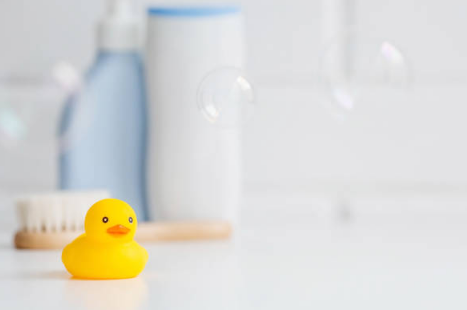We’ve all been in a situation where you go and pick up your child’s bath toy while you’re in the shower, and then you find that it’s moldy. (Good luck trying to hide that toy and get your child through the rest of the bath!) While some bacteria have been found to be good for your child, such as boosting children’s defenses against asthma and allergies, not all bacteria are created equal. Here’s how to keep bath time clean for fun, including why you need to clean bath toys, how to clean them, and how to prevent mold.

Why Clean Bath Toys
A 2018 study proves that parents have always known that there is a high chance that bacteria and/or mold are lurking on their children’s toys, especially bath toys. Bathrooms and bathing environments are breeding grounds for bacterial growth due to high humidity and a perfect storm of human secretions like plastic, soap and sweat, the study said. Biofilm (aka microbial growth) can multiply inside bath toys as soon as they have the opportunity, with squeaky toys such as rubber ducks being the most severe.
The study also outlines the worst nightmare scenario for parents: because children squeeze toys easily, they may get everything. Dirty water from various infections (albeit unintentionally) sprays into their eyes, noses, and mouths. So, while it’s extremely rare for bath toys to cause serious illness, it’s important to maintain and clean them regularly.
How to Clean Bath Toys
Parents know they need to clean bath toys, but sometimes this task can lag behind things like vacuuming car seats and cleaning humidifiers. Here are some different strategies for cleaning your child’s bath toys.
Wash with Soap and Warm Water
If you remember, quickly wash your bath toys with warm, soapy water after each use and air dry them completely in a well-ventilated area. Anything that resembles a container, such as a boat, can be placed on its side or upside down to prevent standing water from breeding bacteria. Squeeze the water out of something soft like a ball. For hard-to-reach places, such as the inside of a cone-shaped object, try using an old toothbrush.
Wash with Vinegar or Hydrogen Peroxide
If you want a gentle method of disinfection, try cleaning toys with a water-vinegar solution or a water-hydrogen peroxide solution. Either way, take equal parts water and solution and soak the toy. After soaking for 15 minutes, squeeze or rinse well, then air dry. Pro tip: Keep the dish soap with vinegar and dish soap in the bathtub. When the toy needs to be dressed up a little, it can be scrubbed clean with it and then air-dried.
Wash with Bleach
If the toy is broken and needs to be vigorously disinfected, bleach can be used. To disinfect with bleach, add 1/2 cup of bleach to a gallon of water. Submerge the toy in water and soak for 10 minutes, then rinse thoroughly with tap water several times, as residual bleach may be harmful to children. This method works best with hard plastic toys that are easy to rinse, rather than soft squeezed toys where bleach may remain.

Ran Through the Dishwasher
The ultimate parenting tip must be the dishwasher. Not all plastic bath toys should be put in the dishwasher, though. Check the original packaging or the actual toy to see if the toy is dishwasher safe – this means it’s a grade of plastic and has been specifically tested to withstand the high temperatures and cycles of the dishwasher. To make the most of your toy’s time in the dishwasher, wash it with soapy water before placing it on the top shelf. Be sure to dry thoroughly before storing. If your toy has small pieces or needs extra protection, place it in your underwear or mesh bag before washing.
Run Through the Laundry Machine
If you have a cloth toy, such as a puppet towel or cloth book, you will most likely be able to put it in the washing machine and wash it. Check the label or original packaging for recommendations. If you want to use the washing machine but are worried about damaging the toy during the spinning process, try pulling the soft toy into your underwear or mesh bag. They will be clean and protected. Allow to air dry well before storing.
When to Throw Away Bath Toys
If your child is starting to enjoy some kind of bath toy that may be moldy, such as a book or a toy that sprays water, it is best to continue to consider buying spare toys because, most likely, these toys will have to be replaced at some point. If you’ve tried cleaning them twice or using two different methods and the mold still doesn’t move, it may be time to throw it away. Solid plastic toys like boats and cups should usually last as long as your child wants to play with the toys if you clean them carefully and correctly.
How to Prevent Mold
Bathroom environments are more prone to mold due to moisture, and the construction of certain toys can make things worse. (Maybe you’ve heard the horror story of a parent cutting open a plastic squeaky toy, only to find black mold inside.) Drying racks or similar containers to help toys breathe, and if you can, dry each toy by hand. If possible, keep the bathroom door open so that moisture escapes and good air circulation, and consider storing toys elsewhere, such as in the hallway or bedroom.
If your child prefers some kind of toy with a hole, such as a rubber duck, and won’t be bothered by it, try plugging the hole with hot glue to prevent water from getting inside.
